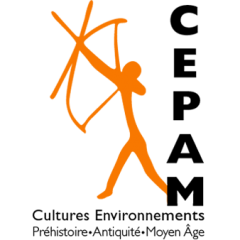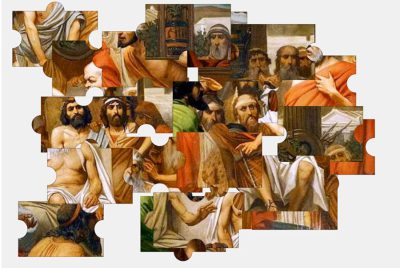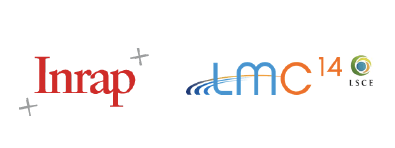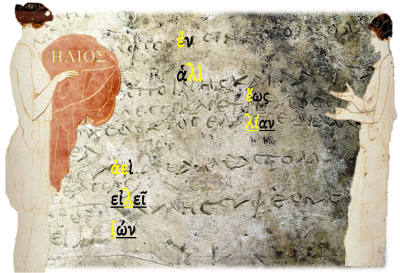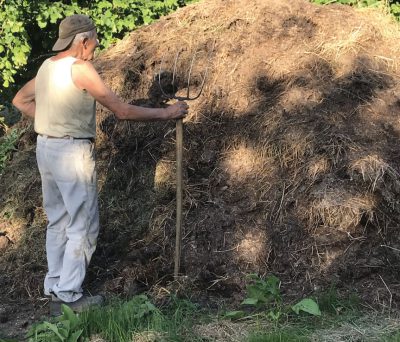Programme
Jeudi 24, Campus Condorcet (Aubervilliers), Bâtiment de recherche Nord, salle 0.010
Accueil : 9h00-9h30
9h30-10h00 Introduction
Session 1 : Antiquité gréco-latine
10h00-11h00 : Conférence inaugurale par Frédérique Biville (Univ. Lumière Lyon 2), Représenter les émissions sonores animalières dans les structures phoniques du langage humain. Le témoignage du monde romain
11h00-11h45 : Ben Broadbent (Michigan Univ.), The Solemnity of Animal Speech in Early Greek Epic Poetry
11h45-12h30 : Oliver Hellmann (Trier Univ.), Animal Sounds in Aelian’s De Natura Animalium
12h30-14h00 Déjeuner dans le patio
14h00-14h45 : Alessandra Scaccuto (Univ. de Siena, Univ. Côte d’Azur), ‘Ergo si varii sensus animalia cogunt /muta tamen cum sint, varias emittere voces’… (Lucrèce, 5.1087-1088) : les variations des chants des oiseaux dans les savoirs zoologiques latins
14h45-15h00 : Maud Pfaff-Reydellet (Univ. de Strasbourg), Le molosse et la corneille : explorer toute la gamme d’émissions sonores des animaux chez Lucrèce, Virgile et Ovide
15h15-16h00 : Thomas Galoppin (Univ. de Toulouse), Quand les chiens aboient, la divinité les entend. Communications animales dans des pratiques divinatoires et des incantations d’époque romaine
16h-16h15 : Pause
Session 2 : Patristique et Islam
16h15-17h00 : Errikos Maniotis (Masaryk Univ.), The interaction between animals and humans in Patristic Christian Theology
17h00-17h45 : Meyssa Ben Saad (Univ. de la Manouba, Tunis), Langage animal versus langage humain ou la distinction fasīḥ a‘ğam dans le Kitāb al-Ḥayawān d’al- Ǧāḥiẓ (776-868)
17h45-18h30 : Nicolas Payen (Ecole normale de Lyon) : Le souffle et la production de sons chez les animaux en Islam médiéval
19h30 Dîner au Campus Condorcet
Vendredi 25 matin, Collège de France, Paris V, salle de conférence, 3 rue d’Ulm
Session 3 : Éthologie
9h00 : accueil
9h15-10h15 : Conférence inaugurale par Dominique Lestel (École normale supérieure, Paris), Qu’est-ce que l’éthologie philosophique ?
10h15-11h00 : Sébastien Deregnaucourt (Univ. Paris-Nanterre et Institut Francilien d’Ethologie) : Que disent les animaux ? L’approche éthologique
11h00-11h45 : Gérard Leboucher (Univ. Paris-Nanterre), À quoi les sons articulés par les animaux non-humains leur servent-ils ?
11h45-12h30 : Hélène Courvoisier (Univ. Paris-Saclay), La bioacoustique : étude scientifique des sons produits par les animaux
12h30-14h30 Déjeuner traiteur à l’Institut catholique de Paris
Vendredi 25 après-midi, Institut catholique de Paris V, salle V20, 74 rue de Vaugirard
Session 4 : Moyen Âge et Renaissance
14h30-15h15 : Donovan Giraud (Univ. de Lyon 2), La voix des corbeaux au Moyen Âge : imitations et apprentissages interspécifiques
15h15-16h00 : Martha Beullens (Katholieke Univ. Leuven), Des oiseaux et des hommes : signifier par le chant chez Albert le Grand
16h00-16h45 : Jean-Marie Fritz (Univ. de Bourgogne), Écrire l’inarticulé : étude comparée des onomatopées animales en latin et dans les langues vernaculaires
16h45-17h00 : Pause
17h00-17h45 : Brigitte Gauvin (Pr. Univ. de Caen-Basse-Normandie), De brutorum loquela agere infructuosum non est… : le De brutorum loquela de Girolamo Fabrizio (1601)
17h45-18h30 : Irène Salas (École des Hautes études en Sciences Sociales), L’étrange « voix humaine » du perroquet : perspectives zoo-poétiques à la Renaissance
18h30 : Conclusions du colloque
19h45 Dîner libre
Présentation
Organisation :
Isabelle Draelants (CNRS-IRHT) – Jean-Charles Ducène (EPHE 4e section-UMR 7192) – Stavros Lazaris (UMR 8167 & ICP-EA 7403) – Arnaud Zucker (Univ. Côte-d’Azur-CEPAM)
Comité scientifique :
Santiago Aragon, Elisabetta Carpitelli, Christophe Chanzedon, Jean-Charles Ducène, Isabelle Draelants, Michel Kreutzer, Stavros Lazaris, Baudouin Van den Abeele, Arnaud Zucker
De naturis animantium :
Leonum est fremere uel rugire, tigridum rancare, pardorum felire, pantherarum caurire, ursorum uncare uel saeuire, aprorum frendere, lyncum urcare, luporum ululare, serpentium sibilare, onagrorum mugilare, ceruorum rugire, boum mugire, equorum hinnire, asinorum rudere uel oncare, porcorum grunnire, uerris quiritare, arietum blatterare, ouium balare, hircorum miccire, haedorum bebare, canum latrare seu baubari, uulpium gannire.
Suétone, Prata, frag. 161
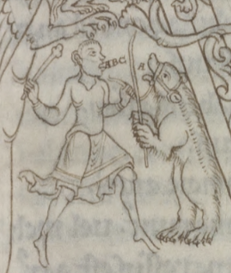
Cette liste de cris d’animaux, conservée dans un fragment de Suétone (Ier EC) a fait l’objet de très nombreuses reprises et enrichissements, depuis l’Antiquité jusqu’aux temps modernes, en passant par Isidore de Séville, les glossaires médiévaux et Alexandre Neckam, pour ne parler que du monde latin. Il est peu d’enfants qui n’ont appris à désigner par un verbe adapté le cri des principaux animaux… La sonosphère humaine est peuplée de voces animales : est-ce un véritable langage ? est-il propre ou partagé ? est-ce un cri, une voix, une parole ? révèle-t-il une intelligence comparable à celle des hommes ? À peu près toutes les cultures se sont posé ces questions et leur ont apporté des réponses diverses, parfois complexes. Dans notre société occidentale, la doxa évolue vers une position « antispéciste », qui remet radicalement en cause, tant du point de vue moral que de celui des aptitudes et des performances sensibles, psychiques, sociales et culturelles, la « différence » humaine. La requalification de l’être humain comme « animal humain » manifeste cette tendance à réinsérer homo sapiens dans l’ordre et la communauté animale, dans l’esprit d’un certain continuisme aristotélicien. Quelle place, quelle fonction et quelle signification donnaient les sociétés anciennes et médiévales aux voces animales ? Si par langage, on entend la faculté qu’a l’humain d’utiliser des sons distinctifs pour exprimer et communiquer des perceptions, des images mentales ou des sensations, les animaux, ou certains d’entre eux, utilisent-ils, selon les Anciens, ce mode d’interaction sonore ?
Le colloque ne vise pas à reprendre la thématique du cri et du son animal sous l’angle lexicographique des verba sonandi, souvent bien étudié, mais à explorer d’autres aspects de la vox animale, dans l’Antiquité grecque et romaine et dans le Moyen Âge latin, byzantin, arabe… Il entend aborder ainsi les conceptions développées par les penseurs et observateurs anciens pour décrire et/ou interpréter les voces des animaux, et les catégories qu’ils ont élaborées pour distinguer le bruit du langage. Ont-ils ainsi, par exemple, distingué le ronronnement du chat de son miaulement ? les variations circonstancielles des chants d’un même oiseau ? De l’observation et de l’analyse, comment et par quel crible sont-ils passés à la dénomination du cri ou du chant ? En vertu de quoi le son émis par l’oiseau a-t-il été élevé au niveau du chant alors que les quadrupèdes, parfois domestiqués depuis longtemps, ont été réduits à pousser des cris, de l’aboiement au bêlement en passant par le hennissement ? L’enjeu de cette rencontre sera aussi de réfléchir aux raisons d’avoir parfois donné la parole aux animaux pour exprimer une réflexion spéculaire sur la société que des hommes, mêmes fictifs, n’auraient osé tenir. S’il arrivait aux Anciens de transposer sur l’animal les paradigmes élaborés par eux pour l’homme, ils mettaient parfois aussi en scène ces animaux tenant des propos qu’il aurait été inconvenant ou dangereux de faire tenir à des hommes. Enfin, comment ont-ils représenté et traduit par l’image ou la musique cet univers sonore animal ?
Aristote dans son Histoire des Animaux (IV.9.535a-b) distingue plusieurs types d’émissions sonores (dialektos, phonè, psophos…) et affirme que certains animaux ont une voix et que d’autres ne produisent que des sons. Mais la distinction qu’il propose repose sur un critère de production physiologique et non sur une valeur sémiologique. La capacité, restreinte à certains animaux à la langue déliée, d’articuler des sons comportant des phonèmes vocaliques et consonantiques, ne caractérise ni ne conditionne l’aptitude à communiquer des messages par des sons. Sur cette base, les lettrés et zoographes antiques et médiévaux ont pensé le « langage » animal, ils l’ont parfois décrit et très souvent dénommé selon les espèces, inaugurant de loin une mimophonétique.
En proposant d’interroger sur ces questions les documents anciens (écrits ou imagés) et les matériaux archéologiques à la lumière des réflexions contemporaines, ce colloque a aussi pour objectif de favoriser, dans l’esprit qui a présidé à la création du réseau international Zoomathia, le dialogue avec les sciences de la vie et du comportement, c’est-à-dire les croisements avec la zoologie ou encore l’éthologie.
Quatre perspectives principales sont proposées pour accueillir les communications :
- Langage animal versus langage humain (approche théorique) : Comment définir le mode d’expression vocale des animaux avec des instruments théoriques pensés pour l’homme ? Cri et son constituent-ils un élément sonore communicationnel partagé ? Le cri chez l’homme est-il une expression hypolinguistique, paralinguistique ? Comment les Anciens marquaient-ils la différence entre ζῷα ἄλογα, animalia muta ou muta bestia (« bestes mues »), d’une part, et animaux « parlants », de l’autre ? Que disent les mythes originels de l’apparition du langage animal et humain et de leurs différences ?
- Sonosphère animale et compréhension (échanges intra-spécifiques et extra-spécifiques) : La question de l’intelligibilité du son et de la voix articulée (p. ex. dans les débats philosophiques et grammaticaux) ; celle des rapports entre langage, compréhension et apprentissage du langage (les débats sur le logos et la prudentia, et la prééminence possible du sens de l’audition sur celui de la vue) ; celle de la possibilité de l’intercommunication homme/animal (p. ex. chez certains saints) et plus largement de la communication interspécifique ; les fonctions des voix animales dans les sociétés humaines et animales (p. ex. cris des oiseaux de proie, écolocalisation) ; l’effectivité des cris animaux sur la vie et l’émotivité humaines et animales (p. ex. les effets du chant du coq, du ronronnement du chat) ; les interprétations des manifestations sonores des animaux, en particulier dans les présages.
- Cris, chant, imitation, musicalité(écriture du son, écriture de la voix) : Les émissions non linguistiques ; l’homologie sonore entre cris animal et humain ; les bruitages animaux ; l’acculturation de ces bruits (dans les littératures, la poésie, le chant et la musique) ; la place des cris d’animaux dans le folklore (p. ex. les concours de chants d’oiseaux) ; les instruments et appeaux ; les voix, vocalises, vocalisations, chants et productions musicales ; la valeur sémiotique des onomatopées et les étymologies onomatopéiques ; la mimophonie (où le son signifiant imite le son signifié) ; la distinction onomastique des animaux entre eux par le cri émis (p. ex. les zoononymes, verba sonandi) ; l’apprentissage du langage humain par l’animal (p. ex. avec les perroquets ou les singes).
- La parole donnée aux animaux(représentation non sonore de la voix des animaux) : La mise en scène de l’animal parlant dans les sociétés animales et humaine : par exemple dans les fables et les romans byzantins (ὉΠουλολόγος, Συναξάριον τοῦ τιμημένου γαδάρου, Διήγησις παιδιόφραστος περὶ τῶν τετραπόδων ζώων…), les fabliaux, le roman de Renart, la « Conférence des oiseaux » de Farid al-Din Attar (dans la 22e épître des Ikhwân al-Safâ)… ; la représentation du son, de la voix, de la parole dans l’iconographie (p. ex. : avec Esope ou Adam parlant aux animaux), l’épigraphie, la littérature.
Les propositions de communication feront l’objet d’une sélection par le comité scientifique. Les communications pourront être prononcées en français, anglais, allemand, italien ou espagnol.
Elles peuvent être envoyées avant le 1er mai 2024 aux adresses suivantes : isabelle.draelants@irht.cnrs.fr ; jean-charles.ducene@ephe.psl.eu ; stavros.lazaris@college-de-France.fr ; arnaud.zucker@univ-cotedazur.fr Le programme sera communiqué début juin 2024.
Publier rapidement les résultats du colloque est un des objectifs des organisateurs ; les contributions écrites seront donc demandées peu de temps après la clôture du colloque.
Le colloque sera suivi d’une demi-journée de réunion entre les partenaires du réseau international de recherche (IRN) Zoomathia.
« They only lack speech », Animal Sounds, Voices and Language in Nature and in Ancient and Medieval Texts
Organisation :
Isabelle Draelants (CNRS-IRHT) – Jean-Charles Ducène (EPHE 4e section-UMR 7192) – Stavros Lazaris (UMR 8167 & ICP-EA 7403) – Arnaud Zucker (Univ. Côte-d’Azur-CEPAM)
Santiago Aragon, Elisabetta Carpitelli, Christophe Chanzedon, Jean-Charles Ducène, Isabelle Draelants, Michel Kreutzer, Stavros Lazaris, Baudouin Van den Abeele, Arnaud Zucker
De naturis animantium :
Leonum est fremere uel rugire, tigridum rancare, pardorum felire, pantherarum caurire, ursorum uncare uel saeuire, aprorum frendere, lyncum urcare, luporum ululare, serpentium sibilare, onagrorum mugilare, ceruorum rugire, boum mugire, equorum hinnire, asinorum rudere uel oncare, porcorum grunnire, uerris quiritare, arietum blatterare, ouium balare, hircorum miccire, haedorum bebare, canum latrare seu baubari, uulpium gannire.
Suétone, Prata, frag. 161

The list of animal vocalizations preserved in a fragment of Suetonius (1st cent. CE) has undergone numerous revisions and additions over the ages, spanning from Antiquity to modern times. Notable contributors include Isidore of Seville, medieval glossaries, and Alexander Neckam, among others in the Latin world. Within the human soundscape, animal voices populate our auditory experience. This begs the question: do these voices constitute a genuine language? Are they exclusively ours or shared with other species? Are they mere cries, voices, or perhaps even words? Do they betray an intelligence akin to that of humans? Such inquiries have intrigued diverse cultures, each offering nuanced and sometimes intricate answers. In Western society, prevailing beliefs are shifting towards an « anti-speciesist » stance, challenging the notion of human exceptionalism both morally and in terms of cognitive, emotional, social, and cultural capacities. This trend towards reclassifying humans as « human animals » reflects a desire to reintegrate Homo sapiens into the broader animal realm, echoing certain Aristotelian continuist philosophies. What roles, functions, and meanings did ancient and medieval societies attribute to animal vocalizations?
The colloquium’s objective isn’t to approach the theme of animal cries and sounds solely from a lexicographical perspective, as often explored, but rather to delve into other dimensions of animal vocalizations. Specifically, the focus lies on examining Greek and Roman antiquity, as well as the Latin, Byzantine, and Arabic Middle Ages. It aims to explore the concepts formulated by ancient thinkers and observers to describe and interpret animal vocalizations, along with the frameworks they devised to distinguish between mere noise and structured language. Did they differentiate between a cat’s purr and its meow, or the contextual variations in a bird’s song? Through observation and analysis, how did they transition from identifying sounds to labeling them as cries or songs? What criteria elevated birdcalls to the status of song, while quadrupeds, despite being domesticated, were relegated to mere cries, from barks to bleats to neighs? Additionally, the symposium seeks to ponder why animals have occasionally been endowed with voices to express societal reflections that even fictitious humans might hesitate to voice. While ancient societies occasionally applied human paradigms to animals, they also depicted animals articulating sentiments deemed inappropriate or perilous for humans to express. Lastly, how did ancient cultures represent and interpret this realm of animal sounds through imagery and music?
In his History of Animals (IV.9.535a-b), Aristotle discerns various types of sound emission (dialektos, phonè, psophos…), positing that some animals possess voices while others produce mere sounds. However, his distinction rests on physiological grounds rather than semiotic value. The capacity to articulate sounds containing vowel and consonant phonemes, limited to select animals with mobile tongues, neither defines nor governs the ability to convey messages through sound. Building on this, ancient and medieval scholars and zoographers pondered the notion of animal « language, » at times describing and often naming it according to species, thus initiating the field of mimophonetics.
By scrutinizing ancient documents—written or pictorial—and archaeological artifacts through the lens of contemporary scholarship, this symposium aims to foster interdisciplinary dialogue with life and behavioral sciences, aligning with the ethos underpinning the international research network Zoomathia, advocating for cross-pollination between zoology and ethology.
The symposium invites contributions exploring four main perspectives:
- Animal language versus human language (theoretical approach): How do we define animal vocal expression using theoretical frameworks developed for humans? Is there a shared communicative element in cries and sounds? Is human crying a hypolinguistic or paralinguistic phenomenon? How did ancient thinkers distinguish between mute animals (ῷα ἄλογα,animalia muta or muta bestia, « bestes mues ») and those capable of « speech »? What insights do original myths offer on the emergence and divergence of animal and human languages?
- Animal soundscape and comprehension (intra- and extra-specific exchanges): Examining the intelligibility of animal sounds and articulated voices (e.g. in philosophical and grammatical debates); the relationship between language, comprehension, and language acquisition (the debates on logos and prudentia, and the possible pre-eminence of the sense of hearing over that of sight); exploring the potential for human-animal intercommunication (e.g. in certain saints); evaluating the functions of animal vocalizations in human and animal societies (e.g., the cries of birds of prey, ecolocalization), and their emotional impact(e.g., the effects of rooster crowing, cat purring); interpretating animal sounds, particularly in the context of omens.
- Cries, songs, imitation, musicality (depicting sound, depicting voice): Exploring non-linguistic sound emissions; drawing parallels between animal and human vocalizations; examining the cultural assimilation of animal sounds in literature, poetry, song, and music; investigating the role of animal cries in folklore (e.g., bird-singing competitions) and their onomatopoeic significance (mymophony); exploring the onomastic distinction of animals from one another by the cry they emit (e.g. zoononyms,verba sonandi); exploring how animals learn human language (e.g. parrots or monkeys).
- Animal speech (representations of animal voices beyond sound): Analyzing depictions of talking animals in various societies through literature, iconography, and epigraphy (e.g. in Byzantine fables and romances as Ὁ Πουλολόγος, Συναξάριον τοῦτιμημένου γαδάρου, Διήγησις παιδιόφραστος περὶ τῶν τετραπόδων ζώων… , in fabliaux, Renart’s novel, in Farid al-Din Attar’s « Conference of Birds » as in the 22nd epistle of the Ikhwân al-Safâ); considering the portrayal of sound, voice, and speech in cultural artifacts (e.g. Aesop or Adam talking to animals); exploring instances of animals assuming roles typically reserved for humans in storytelling traditions.
The scientific committee will select proposals for papers. Papers may be presented in French, English, German, Italian, or Spanish. Submissions can be sent before May 1, 2024, to the following addresses: isabelle.draelants@irht.cnrs.fr; jean-charles.ducene@ephe.psl.eu; stavros.lazaris@college-de-France.fr; arnaud.zucker@univ-cotedazur.fr. The program will be announced in early June 2024.
One of the organizers’ goals is to expedite the publication of the colloquium’s findings; therefore, written contributions will be requested shortly after the conclusion of the colloquium.
Following the symposium, there will be a half-day meeting involving partners of the Zoomathia International Research Network (IRN).
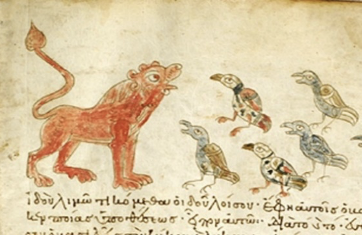
Rencontres scientifiques à venir
Consulter toutes les rencontresConference | Peripatetic Ethics in Theophrastus and After
Project Theophrastus
Appel à communication et à posters | Les datations « absolues » en archéologie
8e séminaire scientifique et technique de l’Inrap
Call for Papers | Ancient and Medieval Greek Etymology as heuristic and pedagogic tool. The case of common words
4th Etygram Conference, April 28-29-30, 2025
44e Rencontres Internationales d’Archéologie et d’Histoire | Fumier, bouses et guano : ordures ou or brun ?
Statut, usage et gestion des déjections animales depuis la Préhistoire ; potentiel archéologique et paléoenvironnemental – 44èmes Rencontres Internationales d’Archéologie et d’Histoire de Nice Côte d’Azur.
Conférence publique | Une Approche Anthropologique du fumier. Un artefact pas comme les autres
à 20h par Sophie LALIGANT, Anthropologue. Professeure des Universités, Université de Tours dans le cadre des 44e RENCONTRES INTERNATIONALES D’ARCHÉOLOGIE ET D’HISTOIRE DE NICE CÔTE D'AZUR
